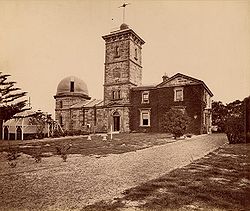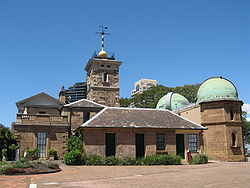
Sydney Observatory
Encyclopedia


Sydney
Sydney is the most populous city in Australia and the state capital of New South Wales. Sydney is located on Australia's south-east coast of the Tasman Sea. As of June 2010, the greater metropolitan area had an approximate population of 4.6 million people...
. The site evolved from a fort built on 'Windmill Hill' in the early 19th century to an astronomical
Astronomy
Astronomy is a natural science that deals with the study of celestial objects and phenomena that originate outside the atmosphere of Earth...
observatory
Observatory
An observatory is a location used for observing terrestrial or celestial events. Astronomy, climatology/meteorology, geology, oceanography and volcanology are examples of disciplines for which observatories have been constructed...
during the nineteenth century. It is now a working museum where evening visitors can observe the stars and planets through a modern 40 cm schmidt-cassegrain telescope and a historic
29 cm refractor telescope built in 1874, the oldest telescope in Australia in regular use.http://www.sydneyobservatory.com.au/about/aboutUs.asp
Early use of the site
In 1796, early on during the European settlement of New South WalesNew South Wales
New South Wales is a state of :Australia, located in the east of the country. It is bordered by Queensland, Victoria and South Australia to the north, south and west respectively. To the east, the state is bordered by the Tasman Sea, which forms part of the Pacific Ocean. New South Wales...
, Australia
Australia
Australia , officially the Commonwealth of Australia, is a country in the Southern Hemisphere comprising the mainland of the Australian continent, the island of Tasmania, and numerous smaller islands in the Indian and Pacific Oceans. It is the world's sixth-largest country by total area...
, a windmill
Windmill
A windmill is a machine which converts the energy of wind into rotational energy by means of vanes called sails or blades. Originally windmills were developed for milling grain for food production. In the course of history the windmill was adapted to many other industrial uses. An important...
was built on the hill above the first settlement. Within ten years the windmill had deteriorated to the point of being useless; the canvas sails were stolen, a storm damaged the machinery, and already by 1800 the foundations were giving way. The name of Millers Point
Millers Point, New South Wales
Millers Point is an urban locality within Sydney's city centre, in the state of New South Wales, Australia. Millers Point is located on the north-western edge of the Sydney central business district, adjacent to The Rocks and is part of the local government area of the City of Sydney.Millers Point...
remembers this early land use.
In 1803, Fort Philip was built on the site under the direction of Governor Hunter
John Hunter (New South Wales)
Vice-Admiral John Hunter, RN was a British naval officer, explorer, naturalist and colonial administrator who succeeded Arthur Phillip as the second governor of New South Wales, Australia from 1795 to 1800.-Overview:...
to defend the new settlement against a possible attack by the French
France
The French Republic , The French Republic , The French Republic , (commonly known as France , is a unitary semi-presidential republic in Western Europe with several overseas territories and islands located on other continents and in the Indian, Pacific, and Atlantic oceans. Metropolitan France...
and also from rebellious convicts
Convictism in Australia
During the late 18th and 19th centuries, large numbers of convicts were transported to the various Australian penal colonies by the British government. One of the primary reasons for the British settlement of Australia was the establishment of a penal colony to alleviate pressure on their...
. The fort was never required to be used for any such purposes. In 1825 the eastern wall of the fort was converted to a signal station. Flags were used to send messages to ships in the harbour and to the signal station on the South Head
Sydney Heads
Sydney Heads , is the entrance to Port Jackson in Sydney, New South Wales, Australia.North Head and Quarantine Head are to the north, South Head and Dunbar Head are to the south. Middle Head, Georges Head and Chowder Head are to the west and within the bay...
of the harbour
Port Jackson
Port Jackson, containing Sydney Harbour, is the natural harbour of Sydney, Australia. It is known for its beauty, and in particular, as the location of the Sydney Opera House and Sydney Harbour Bridge...
.
Observatory

Parramatta, New South Wales
Parramatta is a suburb of Sydney, in the state of New South Wales, Australia. It is located in Greater Western Sydney west of the Sydney central business district on the banks of the Parramatta River. Parramatta is the administrative seat of the Local Government Area of the City of Parramatta...
in 1821 by Governor Sir Thomas Brisbane
Thomas Brisbane
Major-General Sir Thomas Makdougall Brisbane, 1st Baronet GCH, GCB, FRS, FRSE was a British soldier, colonial Governor and astronomer.-Early life:...
.
In 1848, a new signal station was built by the Colonial Architect
New South Wales Government Architect
The New South Wales Government Architect is an officer of the New South Wales government. Historically, the government architect was in charge of the state government's public building projects....
, Mortimer Lewis
Mortimer Lewis
Mortimer William Lewis , was an English architect and surveyor who migrated to Australia and became Colonial Architect in the state of New South Wales from 1835 to 1849. Lewis was responsible for designing and overseeing many government buildings in Sydney and rural New South Wales, many of which...
, on top of the fort wall on Windmill Hill. At the instigation of the Governor, Sir William Denison
William Denison
Sir William Thomas Denison, KCB was Lieutenant Governor of Van Diemen's Land from 1847 to 1855, Governor of New South Wales from 20 January 1855 to 22 January 1861, and Governor of Madras from 1861 to 1866....
, it was agreed seven years later to build a full observatory next to the signal station. The first Government Astronomer, William Scott
William Scott (astronomer and clergyman)
William Scott , was a Church of England clergyman and became the colonial astronomer for New South Wales.-Background:...
, was appointed in 1856, and work on the new observatory was completed in 1858.
The most important role of the observatory was to provide time through the time-ball tower
Time ball
A time ball is a large painted wooden or metal ball that drops at a predetermined time, principally to enable sailors to check their marine chronometers from their boats offshore...
. Every day at exactly 1.00 pm, the time ball on top of the tower would drop to signal the correct time to the city and harbour below. At the same time a cannon on Dawes Point was fired, later the cannon was moved to Fort Denison
Fort Denison, New South Wales
-References:* City Of Sydney Website; , Accessed Jun 2006.* NSW Government; , , Accessed Jun 2006.* Foundation for National Parks & Wildlife, , , Accessed Jun 2006....
. The first time ball was dropped at noon
Noon
Noon is usually defined as 12 o'clock in the daytime. The word noon is also used informally to mean midday regarding the location of the sun not the middle of a persons day. Although this is a time around the middle of the day when people in many countries take a lunch break...
on 5 June 1858. Soon after the drop was rescheduled to one o'clock. The time ball is still dropped daily at 1pm using the original mechanism, but with the aid of an electric motor, not as in the early days when the ball was raised manually.
The observatory is a sandstone
Sydney sandstone
Sydney sandstone is the common name for Sydney Basin Hawkesbury Sandstone, historically known as Yellowblock, is a sedimentary rock named after the Hawkesbury River north of Sydney, where this sandstone is particularly common....
building in the Italianate style. There are two telescope domes on octagonal bases and a four story tower for the time ball. The 1858 building designed by the Colonial Architect, Alexander Dawson, comprised a dome to house the equatorial telescope
Equatorial mount
An equatorial mount is a mount for instruments that follows the rotation of the sky by having one rotational axis parallel to the Earth's axis of rotation. This type of mount is used for astronomical telescopes and cameras...
, a room with long, narrow windows for the transit telescope, an office for calculations, and a residence for the astronomer
Astronomer
An astronomer is a scientist who studies celestial bodies such as planets, stars and galaxies.Historically, astronomy was more concerned with the classification and description of phenomena in the sky, while astrophysics attempted to explain these phenomena and the differences between them using...
. A western wing was added in 1877 with office and library space and a second dome for another telescope. Some of the first astronomical photographs of the southern sky were taken at the observatory, under the direction of Henry Chamberlain Russell
Henry Chamberlain Russell
Henry Chamberlain Russell, CMG, FRS, was an Australian astronomer and meteorologist.-Early life:Russell was born at West Maitland, New South Wales, the fourth son of the Hon. Bourn Russell and his wife Jane, née Mackreth...
. The observatory also took part in the compilation of the first atlas
Atlas
An atlas is a collection of maps; it is typically a map of Earth or a region of Earth, but there are atlases of the other planets in the Solar System. Atlases have traditionally been bound into book form, but today many atlases are in multimedia formats...
of the whole sky, The astrographic cataðlogue. The part completed at Sydney took over 70 years, from 1899 to 1971, and filled 53 volumes.
After the federation of Australia in 1901
Federation of Australia
The Federation of Australia was the process by which the six separate British self-governing colonies of New South Wales, Queensland, South Australia, Tasmania, Victoria and Western Australia formed one nation...
, meteorology
Meteorology
Meteorology is the interdisciplinary scientific study of the atmosphere. Studies in the field stretch back millennia, though significant progress in meteorology did not occur until the 18th century. The 19th century saw breakthroughs occur after observing networks developed across several countries...
became a function for the Commonwealth Government from 1908, while the observatory continued its astronomical role. The observatory continued to contribute observations to The astrographic catalogue, kept time and provided information to the public. For example, each day the Observatory supplied Sydney newspapers with the rising and setting times of the sun, moon and planets. A proposal to close the observatory in 1926 was narrowly avoided, but, by the mid-1970s, the increasing problems of air pollution
Air pollution
Air pollution is the introduction of chemicals, particulate matter, or biological materials that cause harm or discomfort to humans or other living organisms, or cause damage to the natural environment or built environment, into the atmosphere....
and city light
Light pollution
Light pollution, also known as photopollution or luminous pollution, is excessive or obtrusive artificial light.The International Dark-Sky Association defines light pollution as:...
made work at the observatory more and more difficult. In 1982, the NSW Government decided that Sydney Observatory was to be converted into a museum of astronomy and related fields as part of what is now the Powerhouse Museum
Powerhouse Museum
The Powerhouse Museum is the major branch of the Museum of Applied Arts and Sciences in Sydney, the other being the historic Sydney Observatory...
.


